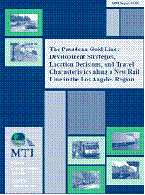- 408-924-7560
- mineta-institute@sjsu.edu
- Donate
The Pasadena Gold Line: Development Strategies, Local Decisions, and Travel Characteristics along a New Rail Line in the Los Angeles Region
The Pasadena Gold Line, a recent extension of the L.A. Metro System, has had a boom in transit-oriented development (TOD) along its corridor, but total ridership has been lower than anticipated. This study, conducted less than one year after rail service began, provides an initial assessment of the travel behavior and residential location choice among TOD residents, baseline data for future assessments, and an exploratory analysis of development issues along a new rail corridor. For a more comprehensive understanding of development and behaviors along the corridor, the study uses both quantitative and qualitative approaches. Quantitative travel and location choice data are collected through household surveys of residents in multifamily buildings within walking distance of a Gold Line station. Interviews with developers and property managers probe the logic and influencing factors behind rail station development and the extent to which rail access is incorporated into building management strategies along new rail lines. By maintaining consistency with a similar statewide TOD study conducted by Lund, Cervero, and Willson
in 2003, the research makes comparisons to other rail systems across California. The research indicates that providing housing within rail station areas can encourage ridership. Station-area residents surveyed were 2.5 times more likely to use transit than residents living in the same area in 2000, before rail service began. This gain was realized although most residents were attracted to the station area because of neighborhood quality and housing factors, not transit access. Residents also walk and bicycle at moderately high levels. The results support the need to further examine and implement transit-supportive policies and development practices: affordable housing, identifying appropriate land-use mixes and parking requirements, creating transit-oriented (not just transit-adjacent) projects, and promoting more transit supportive workplace policies (at TOD and non-TOD locations). Ridership could increase if TODs can attract more transit-dependent persons (those with fewer vehicles or lower incomes, and seniors). Future studies should monitor ridership and development trends as the Gold Line and its station areas mature.
HOLLIE LUND, PhD
Hollie Lund is an assistant professor of urban and regional planning at California State Polytechnic University, Pomona. Her areas of specialty are local transportation planning, transportation-land use interactions, and community revitalization. Dr. Lund was primary investigator on the statewide TOD study funded by Caltrans in 2003.
RICHARD W. WILLSON, PhD, AICP
Richard W. Willson is department chair and professor of urban and regional planning at California State Polytechnic University, Pomona. Dr. Willson’s research in transportation planning addresses land use-transportation relationships, travel demand management, and parking policy. He also consults with regional and local transportation agencies and was a co-researcher on the 2003 Caltrans TOD study.
-
Contact Us
San José State University One Washington Square, San Jose, CA 95192 Phone: 408-924-7560 Email: mineta-institute@sjsu.edu






